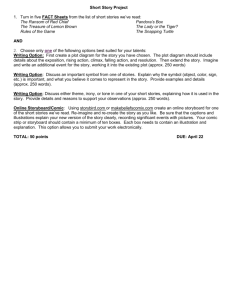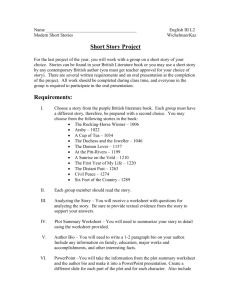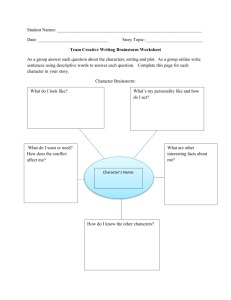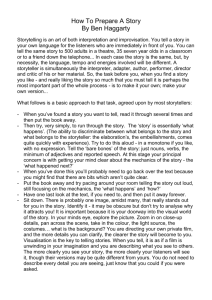Teaching the Art of Storytelling (word document)
advertisement
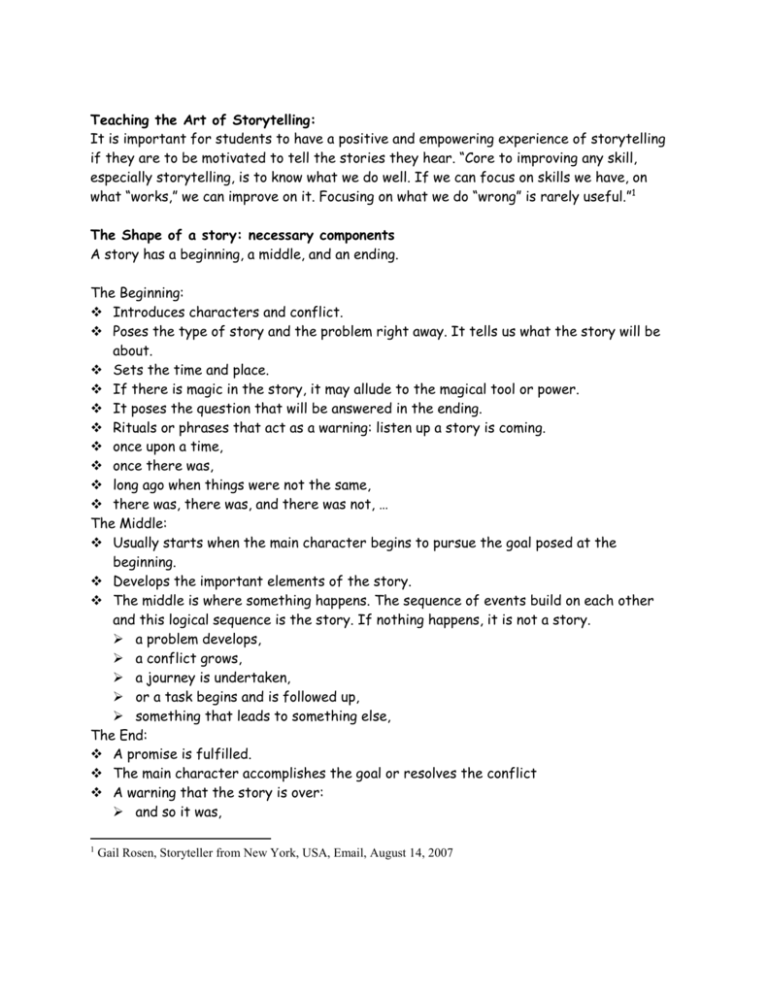
Teaching the Art of Storytelling: It is important for students to have a positive and empowering experience of storytelling if they are to be motivated to tell the stories they hear. “Core to improving any skill, especially storytelling, is to know what we do well. If we can focus on skills we have, on what “works,” we can improve on it. Focusing on what we do “wrong” is rarely useful.”1 The Shape of a story: necessary components A story has a beginning, a middle, and an ending. The Beginning: Introduces characters and conflict. Poses the type of story and the problem right away. It tells us what the story will be about. Sets the time and place. If there is magic in the story, it may allude to the magical tool or power. It poses the question that will be answered in the ending. Rituals or phrases that act as a warning: listen up a story is coming. once upon a time, once there was, long ago when things were not the same, there was, there was, and there was not, … The Middle: Usually starts when the main character begins to pursue the goal posed at the beginning. Develops the important elements of the story. The middle is where something happens. The sequence of events build on each other and this logical sequence is the story. If nothing happens, it is not a story. a problem develops, a conflict grows, a journey is undertaken, or a task begins and is followed up, something that leads to something else, The End: A promise is fulfilled. The main character accomplishes the goal or resolves the conflict A warning that the story is over: and so it was, 1 Gail Rosen, Storyteller from New York, USA, Email, August 14, 2007 at least for awhile, they shook hands and peace reigned again, they found that life could go on. Elements of a Story that is Good For Telling: All stories need: Characters Setting Plot To be tellable, the story needs clear lines, vivid images, interesting characters, and movement. Something has to happen. And the audience has to care about the outcome. Is this a tellable story? Questions to ask: Does this story have vivid characters that you can picture easily? Does the plot move along quickly? Is there dialogue? Is it clear who is speaking and when they are speaking? Is there a conflict or a problem to solve? Is there enough detail to stimulate imagination? Does the story ignite feelings in the teller? Is there a special meaning or significance to this story? So you are going to tell stories in your classroom: How to Select a Story First, you must find a story you like! It’s a bit like buying a suit - does it fit you? For ease of learning, try folktales; they have pattern, repetition, predictability. They have been honed by tellers throughout the ages. Getting to Know Your Story Choose one you really like! So that you will enjoy telling it again and again. Consider why, where, when, and to whom you plan to tell the story. Think about the age, needs, and background of the listeners/ participants. Ensure the story has a straightforward plot, one protagonist, not too many characters, not too much description (you can adapt). Avoid long dialogues as listeners lose track (Rule of Three: three speakers is one too many)! Focus: Read the story aloud several times (assuming it’s in written form). What is the story’s theme or “spine”? What makes this story speak to you? Decide the Most Important Thing about this story (the MIT). It could be the lesson, the excitement, the character, the humour, the language, the plot twists, or anything else that makes you love this story. (Note: your MIT might change over a few tellings!) Get Inside the Story: Every story has setting, character(s) and plot. To “own” the setting, visualize the place – the sights, sounds, smells, textures. Put yourself inside the minds and emotions of the characters. Ask yourself why they do and say what they do. For plot, try creating a story map or storyboard, making a summary chart, listing key scenes in sequence giving subtitles to each little section of the story. Repeat: Use a learning style that suits you. Walk while you read the story for a kinesthetic effect. Use visual cues from a story map or storyboard. Read or tell the story into a recording device and play it back for yourself. Tell yourself “about” the story. Don’t try to duplicate the words of the original. Make adaptations that seem right to you. (Note: stories published by authors (non-traditional) require permission for changes as well as for telling.) Decide if you want to memorize the beginning or ending, or certain key phrases. Some stories have roles for audience participation. Decide how you will handle this. Tell “about” the story to a friend OR tell them the story. Ask for any comments on your gestures, pacing, vocal and facial expressions but remember the MIT is really what you’re after. Learning a Story Tell the story again. Tell the story again and again and again…. The Worksheet that follows is one of MANY techniques to help you “make the story your own”. You may want to make copies of this worksheet for future use. Try all of the techniques suggested. See which one fits you best, but be aware, different stories are often best learned in different ways, so try a number of “learning techniques” with each new story. Story Summary Worksheet NAME:_________________ The name of the story I want to tell is ________________________________ From (book/author)___________________________________________________ The country/culture that my story comes from __________________________ Where does the story take place?____________________________________ List the main characters and a few words to describe each: _________________ ______________________________________________________________ ______________________________________________________________ ______________________________________________________________ What is the beginning? __________________________________________ __________________________________________________________________________ What is the problem?______________________________________________ ______________________________________________________________ What is the middle? ______________________________________________ ______________________________________________________________ List the events in order: ______________________________________________________________ ______________________________________________________________ ______________________________________________________________ ______________________________________________________________ ______________________________________________________________ What is the end? ______________________________________________________________ ______________________________________________________________ What is the main idea? ____________________________________________ ______________________________________________________________ ______________________________________________________________ ______________________________________________________________ List phrases that should be memorized? _______________________________ ______________________________________________________________ ______________________________________________________________ ______________________________________________________________ ______________________________________________________________ What are the closing lines that end the story? __________________________ ______________________________________________________________ ______________________________________________________________ Draw your storyboard or story map here:
